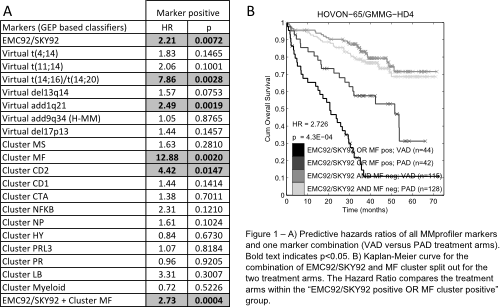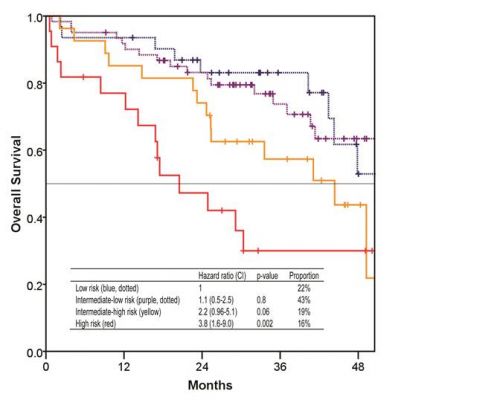Mocht u de informatie op onze website kanker-actueel.nl waarderen dan wilt u ons misschien ondersteunen met een donatie?
Ons rekeningnummer is: RABO 37.29.31.138 t.n.v. Stichting Gezondheid Actueel in Terneuzen. Onze IBANcode is NL79 RABO 0372 9311 38
Als donateur kunt u ook korting krijgen bij verschillende bedrijven. En we hebben een ANBI status
14 mei 2020:
Nieuwe studiegegevens bevestigen de waarde van de MMprofiler genentest: Klik op de titel van de studie voor het studierapport:
Waaruit bleek dat wie multiple myeloma heeft met hoog risico hogere scores hadden in de genentest en minder profiteerden van bv alleen lenalidomide:
Our results demonstrate that patients with double-hit or GEP high-risk status are unlikely to benefit from current treatment approaches, including single agent lenalidomide maintenance therapy. In such patients intensified ongoing therapy with combination agents may be beneficial [3]. Such an assertion will be prospectively assessed in clinical studies such as the risk stratified UK OPTIMUM (MUKnine) trial (NCT03188172).
In conclusion, our findings support the further adoption of molecular biomarkers to stratify NDMM patient therapy. Zie verder studierapport en verderop hieronder in het artikel.
In Engeland wordt de SKY92 MMProfiler genentest inmiddels vergoed vanuit de basisverzekering na weer bevestigde resultaten uit deze nieuwe studie met de genentest. Zie dit persbericht: https://www.skylinedx.com/news/private-health-insurance-reimburses-mmprofiler-with-sky92-for-patients-united-kingdom
25 juli 2019: zie ook dit artikel:
7 december 2015: Twee studies bewijzen opnieuw de waarde van de genentest die het bedrijf Skyline DX heeft ontwikkeld voor Multiple Myeloma, ziekte van Kahler en hieronder uitvoerig wordt besproken. Het verschil tussen 5-jaars overleving voor laag risicopatiënten en hoog risicopatiënten was maar liefst 100% versus 28%. Meer dan de moeite waard dus voor artsen (en patiënten uiteraard) om vantevoren deze genentest uit te laten voeren.
Hier studie 1 zoals gepresenteerd op de ASH deze week:
The Combination of SKY92 and ISS Provides a Powerful Tool to Identify Both High Risk and Low Risk Multiple Myeloma Cases, Validation in Two Independent Cohorts
Studie 2:
Validation of the EMC92/SKY92 Signature in HOVON-87/Nmsg-18: Gene Expression Based Prognostication Is Applicable in Elderly Patients with Newly Diagnosed Multiple Myeloma
Lees verder hieronder meer over deze genentest voor Multiple Myeloma:
30 juli 2014: Bron: Leukemia (2012) 26, 2406–2413; doi:10.1038/leu.2012.127; published online 22 June 2012 en EHA congres in Milaan - Erasmus Medisch Centrum
Genentest blijkt voorspellende waarde te hebben bij het verloop van Multiple Myeloma - ziekte van Kahler bij nieuw gediagnosteerde patiënten.
Onderzoekers van de Erasmus Universiteit en het Erasmus Medisch Centrum en het bedrijf SkylineDX, een bedrijf dat samenwerkt met het Erasmus Medisch Centrum, of onderdeel is ervan want waarvan het hoofdkantoor in Rotterdam in het gebouw van de Erasmus is gevestigd, heeft een fase III studie gepubliceerd waar uitkwam dat 5 bepaalde genen (er werden 92 genen getest via een zogeheten GEP = Gen Expressie Profielen) een voorspellende waarde hebben bij het wel of niet aanslaan van een behandeling met proteasome remmers zoals het bij Multiple Myeloma veel gebruikte Bortesomib - Velcade.
De 5 afwijkingen die bij verschillende aanpak van de ziekte eruit springen qua voorspellende waarde zijn: t(14;16), t(14;20), add1q21, MF en CD2 cluster.

Uit een eerdere studie gepubliceerd in 2012 was gebleken dat wanneer patiënten een zogeheten EMC-92 afwijking hadden zij significant minder kans op overall overleving hadden.
Studieresultaten van die studie:
De onderzoekers verkregen via de GEP - gen expressie profielen test resultaten van 290 patiënten met nieuw gediagnosteerde Multiple myeloma - ziekte van Kahler (ook wel botkanker genoemd) binnen de HOVON65/GMMG-HD4 studie. Daarnaast werd in verschillende controlegroepen deze resultaten vergeleken. Deze groepen waren onderverdeeld in totaal therapie (TT) 2, n = 351; TT3, n = 142; MRC-IX, n = 247) en bij recidiverende patiënten (APEX, n = 264)
In alle groepen waren patiënten gedefinieerd als patiënten met een hoog risico. Patienten met een EMC-92-gen afwijking toonden een duidelijk verminderde totale overleving (OS) met een hazard ratio (HR) van 3,40 (95% betrouwbaarheidsinterval (BI): 2,19-5,29) voor de TT2 studie, 5.23 (95% BI: 2,46-11,13) voor de TT3 studie, 2,38 (95%-BI: 1,65-3,43) voor de MRC-IX studie en 3.01 (95% BI: 2,06-4,39) voor de APEX studie (P <0,0001 bij alle studies).
Nederlandse studie:
Onderzoekers aan de Erasmus universiteit hebben de GEP test - Gen Expressie Profielen inmiddels in een fase III studie vergeleken en uitgevoerd bij 329 patiënten met Multiple Myeloma die verschillende behandelingen hebben gehad. De chemo combinatie bortezomib - velcade, doxorubicin, en dexamethasone (PAD), gevolgd door hoge dosis melphalan en (HDM)/autologe stamcel transplantatie (ASCT) en onderhoudsbehandeling met bortezomib werd vergeleken met vincristine, doxorubicin, en dexamethasone (VAD) gevolgd door (HDM)/autologe stamcel transplantatie (ASCT) en onderhoudsbehandeling met thalidomide.
Patiënten met 1 of meer genen positief getest uit de GEP test: t(4;14), t(11;14), t(14;16)/t(14;20), add1q, add9q. del13, en del17 bleken langer te leven (OS = overall overleving) met de PAD behandeling (bortezomib - velcade, doxorubicin, en dexamethasone) dan op de VAD behandeling (vincristine, doxorubicin, en dexamethasone).
Conclusie:
De onderzoekers concluderen dan ook dat een gentest bij nieuwe patiënten met Multiple Myeloma - ziekte van Kahler zinvol kan zijn om daarop een behandelingsvoorstel te maken.
Zie ook in gerelateerde artikelen dat Franse onderzoekers enkele jaren geleden al de genenafwijkingen vonden die aan de basis liggen van Multiple Myeloma.
Hier respectievelijk het abstract van de studie uit 2012: http://www.nature.com/leu/journal/v26/n11/abs/leu2012127a.html en het abstract van de studie: PROTEASOME INHIBITOR TREATMENT RESPONSE CAN BE PREDICTED BY GENE EXPRESSION PROFILING IN MULTIPLE MYELOMA zoals deze werd gepresenteerd op het laatste EHA congres in Milaan.
A gene expression signature for high-risk multiple myeloma
Leukemia (2012) 26, 2406–2413; doi:10.1038/leu.2012.127; published online 22 June 2012
There is a Corrigendum (7 May 2014) associated with this article
R Kuiper1,9, A Broyl1,9, Y de Knegt1, M H van Vliet2, E H van Beers2, B van der Holt3, L el Jarari3, G Mulligan4, W Gregory5, G Morgan6, H Goldschmidt7, H M Lokhorst8, M van Duin1 and P Sonneveld1
- 1Department of Hematology, Erasmus University Medical Center, Rotterdam, The Netherlands
- 2Skyline Diagnostics, Erasmus Medical Center, Rotterdam, The Netherlands
- 3HOVON Data Center, Erasmus MC-Daniel den Hoed, Rotterdam, The Netherlands
- 4Millennium Pharmaceuticals, Cambridge, MA, USA
- 5 Clinical Trials Research Unit, University of Leeds, Leeds, UK
- 6Haemato-oncology Unit, Royal Marsden Hospital, London, UK
- 7Department of Internal Medicine V, University of Heidelberg, Heidelberg, Germany
- 8Department of Hematology, University Medical Center Utrecht, Utrecht, The Netherlands
Correspondence: P Sonneveld, Department of Hematology, Erasmus University Medical Center, L-413, PO Box 2040, 3000 CA Rotterdam, The Netherlands. E-mail: p.sonneveld@erasmusmc.nl
9These authors contributed equally to this work.
Received 22 February 2012; Revised 19 April 2012; Accepted 25 April 2012
Accepted article preview online 8 May 2012; Advance online publication 22 June 2012
Abstract
There is a strong need to better predict the survival of patients with newly diagnosed multiple myeloma (MM). As gene expression profiles (GEPs) reflect the biology of MM in individual patients, we built a prognostic signature based on GEPs. GEPs obtained from newly diagnosed MM patients included in the HOVON65/GMMG-HD4 trial (n=290) were used as training data. Using this set, a prognostic signature of 92 genes (EMC-92-gene signature) was generated by supervised principal component analysis combined with simulated annealing. Performance of the EMC-92-gene signature was confirmed in independent validation sets of newly diagnosed (total therapy (TT)2, n=351; TT3, n=142; MRC-IX, n=247) and relapsed patients (APEX, n=264). In all the sets, patients defined as high-risk by the EMC-92-gene signature show a clearly reduced overall survival (OS) with a hazard ratio (HR) of 3.40 (95% confidence interval (CI): 2.19–5.29) for the TT2 study, 5.23 (95% CI: 2.46–11.13) for the TT3 study, 2.38 (95% CI: 1.65–3.43) for the MRC-IX study and 3.01 (95% CI: 2.06–4.39) for the APEX study (P<0.0001 in all studies). In multivariate analyses this signature was proven to be independent of the currently used prognostic factors. The EMC-92-gene signature is better or comparable to previously published signatures. This signature contributes to risk assessment in clinical trials and could provide a tool for treatment choices in high-risk MM patients.
PROTEASOME INHIBITOR TREATMENT RESPONSE CAN BE PREDICTED BY GENE EXPRESSION PROFILING IN MULTIPLE MYELOMA
Martin H Van Vliet* 1, Rowan Kuiper2, Annemiek Broijl2, Mark Van Duin2, Leonie de Best1, Erik H van Beers1, Pieter Sonneveld2
1SkylineDx BV, 2Department of Hematology, Erasmus MC Cancer Institute, Rotterdam, Netherlands
Background:
Multiple Myeloma (MM) is a heterogeneous disease in terms of genetic background, survival and treatment response for which more and more ‘novel agents’ become available. However, there is a large diversity between subgroups of patients in treatment response and survival. This signifies an ever increasing need for predictive markers for MM that may allow identification of such subgroups at time of diagnosis. Gene Expression Profiling (GEP) studies have resulted in several markers, such as the EMC92/SKY92 high risk signature, virtual karyotyping (t(4;14), t(11;14), etc.), and the GEP clusters (MS, MF, etc.).
Aims:
To identify predictive GEP based markers capable of distinguishing patients that benefit from proteasome inhibitor based treatment.
Methods:
The data from the HOVON-65/GMMG-HD4 phase 3 trial was used, in which bortezomib, doxorubicin, and dexamethasone (PAD), followed by high dose melphalan (HDM)/autologous stem cell transplantation (ASCT) and bortezomib maintenance was compared with vincristine, doxorubicin, and dexamethasone (VAD) followed by HDM/ASCT and thalidomide maintenance. GEP was performed (Affymetrix U133 Plus 2.0 GeneChip; algorithms: MMprofiler assay) for 329 MM patients.
A subset of this dataset was previously used as a training set for the EMC92/SKY92 signature (290 patients), for the signatures of the 12 clusters (320 patients), as well as for the signatures for chromosomal aberrations (virtual karyotyping of t(4;14), t(11;14), t(14;16)/t(14;20), add1q, add9q. del13, and del17, number of patients depending on the FISH). The predictive power for Overall Survival (OS) of those markers in relation to the PAD/VAD treatment arms was assessed. For each marker, a Cox Proportional Hazards model was fit on the patients that are positive for that marker, with samples split into PAD/VAD as covariate. A Hazard Ratio (HR) larger than 1 indicates that PAD patients had longer OS than those treated with VAD (uncorrected p values also reported).
Results:
The predictive power of the EMC92/SKY92 signature, markers for the various chromosomal aberrations and GEP clusters was assessed by comparing VAD with PAD.
Five markers, EMC92/SKY92, t(14;16)/t(14;20), add1q21, MF and CD2 cluster, were found to have longer OS when treated with PAD (HR ranging from 2.2 to 12.9, p<0.05, Figure 1A).
t(4;14) shows improved survival when treated with PAD (HR=1.8), but is not significant (p=0.15).
These markers capture different biological mechanisms, and therefore different sets of patients.
For example, the EMC92/SKY92 (23.1% of patients) and cluster MF (6.4% of patients) together identify 26.1% of patients with an HR of 2.7 (Figure 1A and B).
These results indicate that GEP markers may provide a good predictive marker for proteasome inhibition therapy.
Summary/Conclusion:
Five GEP markers have been found that can predict longer OS in subsets of MM patients when treated with proteasome inhibitors (PAD/Bortezomib), suggesting that they may serve as a predictive marker. The predictive power of these markers must be validated in the EMN-02/HOVON-95 clinical trial which will include a bortezomib based induction regimen, and consolidation regimen.
Gerelateerde artikelen
- CTX-1 (C-terminaal telopeptide 1) geeft bij stijgende waarden aan dat bij patiënten met Multiple Myeloma (Kahler - botkanker) met stabiele ziekte er snel een recidief en ziekteprogressie zal ontstaan.
- Genentest: Erasmus MC biedt aan alle patienten met diagnose van Multiple Meyloma (Kahler) een genentest aan op 92 genen om optimale behandeling te kunnen geven.
- Genentest SKY92 van Nederlands bedrijf SkylineDX blijkt uitstekende prognoses te geven bij Multiple Myeloma (MM), ziekte van Kahler.
- Genentest bij diagnose voorspelt vrij nauwkeurig ziekteverloop bij Kahler - Multiple Myeloma toont onderzoek aan
- Reguliere oncologie: Kahler - Multiple Myeloma - botkanker: een overzicht van recente ontwikkelingen binnen de reguliere oncologie bij elkaar gezet




Plaats een reactie ...
Reageer op "Genentest blijkt voorspellende waarde te hebben bij het verloop van Multiple Myeloma - ziekte van Kahler. Ook bij eerste diagnose."